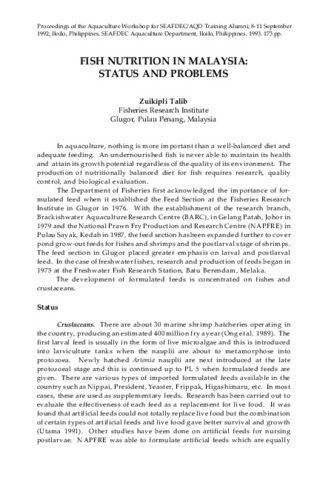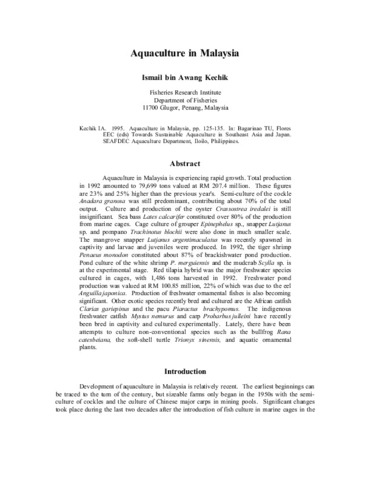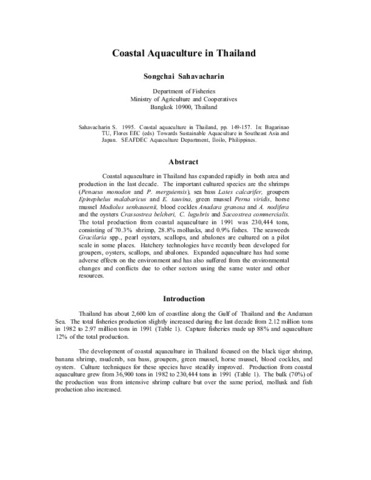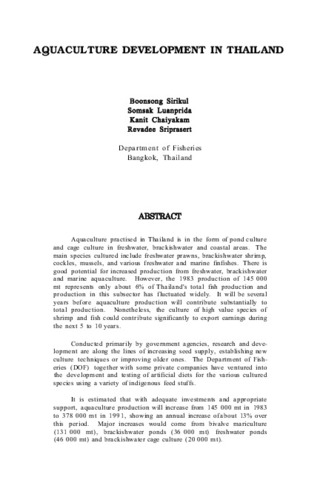Fish nutrition in Malaysia: Status and problems

ရှာဖွေ/ဖွင့်ပါ။
ရက်စွဲ
1993စာရေးသူ
Page views
821
Share
စိတ္တဇ
In aquaculture, nothing is more important than a well-balanced diet and adequate feeding. An undernourished fish is never able to maintain its health and attain its growth potential regardless of the quality of its environment. The production of nutritionally balanced diet for fish requires research, quality control, and biological evaluation. The Department of Fisheries first acknowledged the importance of formulated feed when it established the Feed Section at the Fisheries Research Institute in Glugor in 1976. With the establishment of the research branch, Brackishwater Aquaculture Research Centre (BARC), in Gelang Patah, Johor in 1979 and the National Prawn Fry Production and Research Centre (NAPFRE) in Pulau Sayak, Kedah in 1987, the feed section has been expanded further to cover pond grow-out feeds for fishes and shrimps and the postlarval stage of shrimps. The feed section in Glugor placed greater emphasis on larval and postlarval feed. In the case of freshwater fishes, research and production of feeds began in 1975 at the Freshwater Fish Research Station, Batu Berendam, Melaka. The development of formulated feeds is concentrated on fishes and crustaceans.
Suggested Citation
Talib, Z. (1993). Fish nutrition in Malaysia: Status and problems. In C. T. Villegas, M. T. Castaños, & R. B. Lacierda (Eds.), Proceedings of the Aquaculture Workshop for SEAFDEC/AQD Training Alumni, 8-11 September 1992, Iloilo, Philippines (pp. 71-73). Tigbauan, Iloilo, Philippines: Aquaculture Department, Southeast Asian Fisheries Development Center.
ဘာသာရပ်
စုစည်းမှုများ စုစည်းမှုများ
Related items
Showing items related by title, author, creator and subject.
-
Aquaculture in Malaysia
Kechik, Ismail bin Awang. (Aquaculture Department, Southeast Asian Fisheries Development Center, 1995)Aquaculture in Malaysia is experiencing rapid growth. Total production in 1992 amounted to 79,699 tons valued at RM 207.4 million. These figures are 23% and 25% higher than the previous year's. Semi-culture of the cockle ... -
Coastal aquaculture in Thailand
Sahavacharin, Songchai (Aquaculture Department, Southeast Asian Fisheries Development Center, 1995)Coastal aquaculture in Thailand has expanded rapidly in both area and production in the last decade. The important cultured species are the shrimps (Penaeus monodon and P. merguiensis), sea bass Lates calcarifer, groupers ... -
Aquaculture development in Thailand
Sirikul, Boonsong; Luanprida, Somsak; Chaiyakam, Kanit; Sriprasert, Revadee (Aquaculture Department, Southeast Asian Fisheries Development Center, 1988)Aquaculture practised in Thailand is in the form of pond culture and cage culture in freshwater, brackishwater and coastal areas. The main species cultured include freshwater prawns, brackishwater shrimp, cockles, mussels, ...




